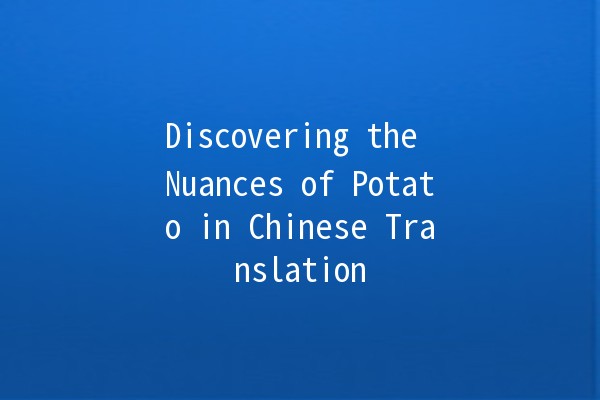In our everglobalizing world, the nuance in word translations can carry significant weight, particularly in languages as rich and diverse as Chinese. When translating a commonly understood term like “potato,” beyond its basic correspondence, there are cultural implications, idiomatic expressions, and regional variations that enhance our understanding of the word. This article dives deep into translating “potato” into Chinese, exploring various facets, tips for improving your translation skills, and reflections on cultural vitality.
Understanding the Term "Potato"
The word "potato" in Chinese is translated as 土豆 (tǔdòu). This term encompasses more than just the agricultural product; it also reflects the lifestyle, culinary practices, and cultural resonance of the potato in Chinese society. To understand how to best translate "potato" requires more than knowing its Chinese equivalent; it involves grasping its significance within context, culture, and conversation.
The Cultural Context of 土豆
The potato's introduction to China in the Ming Dynasty marked an agricultural revolution that has continued to evolve. Originally, it was regarded as a lesser food, overshadowed by rice and wheat. However, due to its adaptability and nutritional benefits, potatoes ultimately found a cherished place in Chinese cuisine and everyday meals. This aspect is crucial when translating "potato" in various contexts, whether for culinary articles, educational materials, or casual conversations.
Five Essential Tips for Effective Chinese Translation
To provide a great understanding of working with translations, especially for terms like "potato," here are five productive techniques that can enhance your translation skills:

Explanation: Always consider the context in which "potato" (土豆) will be used. Cultural context greatly influences translation choices, including collocations and idiomatic usage.
Example: When discussing a dish, a translator might emphasize “马铃薯 (mǎlíngshǔ)” for regions where this term is more familiar, like Sichuan, where the term is associated with specific dishes like potato salad or spicy stirfried potatoes.
Explanation: Languages have regional variations and dialects that influence vocabulary and expressions. It’s beneficial to be aware of these differences.
Example: In northern China, "potato" is commonly referred to as 土豆, while in regions such as Guizhou, you might hear different local names depending on the dish or the source of the potato.
Explanation: Sometimes, a visual can bridge the gap in understanding. Using images of the product in its context can clarify meaning and enhance comprehension.
Example: If you're translating recipes or agricultural content, visuals of 土豆 in various dishes or states (raw, cooked, mashed) can help convey much more than words alone.
Explanation: Drawing parallels between the two cultures enhances understanding. The way "potato" is viewed through a cultural lens can change its translation needs.
Example: Discussing the cultural importance of potatoes in Western fast food versus their role in traditional Chinese meals can lead to richer descriptions and translations that resonate with the reader.
Explanation: Encourage practicing translation in interactive environments, such as language exchange programs or cooking classes.
Example: Participating in a class to learn how to cook Chinese potato dishes allows translators to learn the lingo and escape everyday contexts, thus improving comprehension.
The Varied Uses of Potato in Chinese Cuisine
The potato plays a significant role in contemporary Chinese cuisine. It’s utilized in countless ways, from traditional dishes to modern interpretations. Some dishes worth noting include:
干煸土豆丝 (gānbiān tǔdòu sī): Spicy StirFried Shredded Potatoes
土豆炖牛肉 (tǔdòu dùn niúròu): Beef Stew with Potatoes
土豆泥 (tǔdòu ní): Mashed Potatoes
土豆饼 (tǔdòu bǐng): Potato Pancakes
These applications not only highlight the versatility of potatoes but also show how a simple ingredient can connect various regional tastes and traditions across China.
s on Cultural and Linguistic Importance
Translating "potato" into Chinese extends far beyond the mapping of one term to another. It weaves together a narrative of history, culture, and everyday life in Chinese society, encapsulating Hubei’s starchy delights or Shanghai’s trendy fries. As language and culture continue to evolve, translators must consider the many layers of meaning that words carry.
Engaging with the Reader
Encouraging readers to delve deeper into the cultural significance of potatoes in their own areas, exploring local variations and traditions, can lead to a more enriching understanding. This engagement not only enhances language skills but also fosters appreciation for cultural diversity.
Frequently Asked Questions about Potato Translations
In addition to 土豆 (tǔdòu) and 马铃薯 (mǎlíngshǔ), there are several regional variations depending on the dialect. Variations may arise in cooking techniques or the dishes themselves when potatoes are featured in traditional meals.
The cultural significance can be attributed to its adaptability in agriculture and culinary practices. The potato represents economic resilience and versatile cuisine, reflecting changing dietary habits and agricultural shifts over centuries.
Yes, in certain rural dialects, potatoes might be referred to by different names and are often linked with specific recipes or local customs. Understanding these terms improves one’s translation quality in those contexts.
Potatoes have permeated contemporary cuisine, appearing in street foods and fastfood chains. An understanding of cooking styles, such as fried or cooked, allows for a better grasp of their contemporary significance.
Understanding nuances fosters empathy towards cultural contexts, improving the ability to convey messages accurately without losing the essence of the original language, thus engaging the target audience better.
Yes, as fast food and international cuisines incorporate potatoes, they represent the melding of traditional and modern lifestyles, emphasizing how global food culture can adapt local flavors and traditions.
, translating "potato" into Chinese reveals much more than a mere word. It uncovers cultural significance, highlights regional dialects, and exemplifies culinary traditions. By embracing the depth of translation, learners, cooks, and language enthusiasts can enrich their experience and understanding of the diverse world surrounding this simple yet significant vegetable.